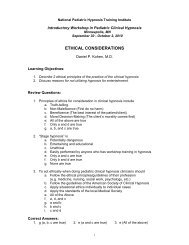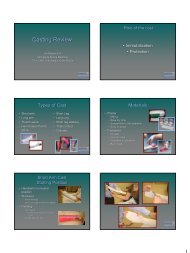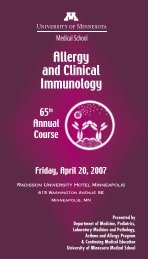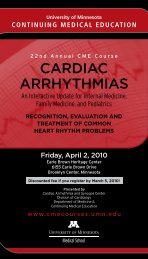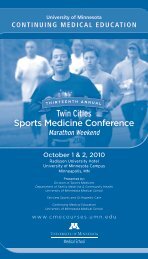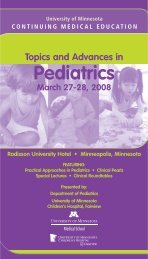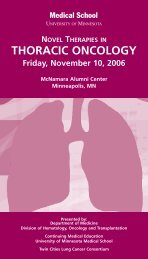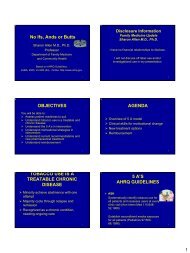A Dozen Sports Medicine Pearls 30+ Years of Clinical Practice ...
A Dozen Sports Medicine Pearls 30+ Years of Clinical Practice ...
A Dozen Sports Medicine Pearls 30+ Years of Clinical Practice ...
You also want an ePaper? Increase the reach of your titles
YUMPU automatically turns print PDFs into web optimized ePapers that Google loves.
A <strong>Dozen</strong> <strong>Sports</strong> <strong>Medicine</strong> <strong>Pearls</strong><br />
from<br />
<strong>30+</strong> <strong>Years</strong> <strong>of</strong> <strong>Clinical</strong> <strong>Practice</strong><br />
Rob Johnson, MD, FACSM, CAQ <strong>Sports</strong> <strong>Medicine</strong><br />
Pr<strong>of</strong>essor, Department <strong>of</strong> Family <strong>Medicine</strong> and<br />
Community Health, UM<br />
Team Physician, UM Athletics<br />
Director, Primary Care <strong>Sports</strong> <strong>Medicine</strong> Fellowship,<br />
HCMC<br />
Objectives<br />
• Learn from experiences <strong>of</strong> “sports medicine<br />
veterans”.<br />
• Use practical “tips” to improve patient care in<br />
msuculoskeletal medicine<br />
• Avoid potential pitfalls in the practice <strong>of</strong> sports<br />
medicine.<br />
#1: Pain is not the injury.<br />
• Pain is merely a symptom <strong>of</strong> the injury.<br />
• Treatment <strong>of</strong> pain is not treating the injury.<br />
• Role <strong>of</strong> analgesia in recovery.<br />
#2: Absence <strong>of</strong> pain does not imply<br />
resolution <strong>of</strong> the problem<br />
• Disappearance <strong>of</strong> pain – what does it mean<br />
• What’s left<br />
• Role <strong>of</strong> pain in recovery.<br />
#3: All physical therapy is not created equal<br />
• Acute injury results in:<br />
– Inhibition (under recruitment) <strong>of</strong> the injured muscletendon<br />
units muscle atrophy<br />
– Over recruitment <strong>of</strong> the uninjured muscle tendon units.<br />
– The implication Strengthen<br />
• For the patient who has already “been to PT”,<br />
ask<br />
“What did you do in PT”<br />
“What was your home exercise program”<br />
“How many times each week did you do or are you<br />
doing the HEP”
Because…<br />
Rather…<br />
• Restoring ROM<br />
• Strengthening the injured part<br />
Modalities<br />
• Gradual return to training and competition<br />
#4: The patient who isn’t improving<br />
according to an expected time frame<br />
• The problem…<br />
• The solution<br />
– Change the treatment<br />
or<br />
– Change the diagnosis<br />
• Example:<br />
– Patell<strong>of</strong>emoral disorder<br />
– Victim<br />
– Culprit<br />
#5: Victim or culprit<br />
#6: Beware the consequences <strong>of</strong> your<br />
imaging<br />
How about this case<br />
The MRI<br />
Back<br />
– Thornbury and colleagues demonstrated a sensitivity <strong>of</strong> MRI for<br />
herniated discs <strong>of</strong> 0.89 to 1.0 but a specificity <strong>of</strong> only 0.43 to 0.57<br />
– Asymptomatic patients: disk bulges (52%) and protrusions (27%)<br />
Shoulder<br />
– Kautzner 2008: accuracy <strong>of</strong> MR for diagnosing labral tears was<br />
68%<br />
– Bergin 2009: MR arthrography: sensitivities <strong>of</strong> 86% to 91% and<br />
specificities <strong>of</strong> 86% to 98%<br />
– <strong>Clinical</strong> significance<br />
Knee<br />
– 61% who had meniscal tears had not had any,pain, aching, or<br />
stiffness during the previous month.
#7: Medications – what they can and cannot<br />
do<br />
• Injections<br />
– Corticosteroids<br />
– Hyaluronic acid<br />
– Proliferants<br />
• NSAID’s<br />
#8: Ordering tests<br />
• Feel no guilt if you don’t order x-rays or lab tests!<br />
• When ordering a test or radiograph ask:<br />
– Will it change my treatment<br />
– Will it change my diagnosis<br />
#9: Non-physiologic symptoms<br />
• My pain is “12 out <strong>of</strong> 10”<br />
• “It’s not really painful, it’s just sore.”<br />
• “It starts in my fingertips and ‘shoooooots’ up my<br />
arm.”<br />
#10: “I’ll be smarter next week.”<br />
• Relieving factors<br />
• How does the pain affect<br />
work<br />
sleep<br />
play<br />
• Consider the confusing constellation <strong>of</strong> symptoms<br />
and/or physical findings.<br />
• Nonspecific findings breed nonspecific<br />
treatments.<br />
• Observation is a legitimate treatment strategy to<br />
see how the sx and signs evolve.
#11: Check the patient’ teeth<br />
#12: Never work harder than your patient<br />
• A compliance test <strong>of</strong> sorts.<br />
• Especially with PT<br />
• Who gave me this advice<br />
• An anecdote<br />
Summary<br />
Good luck tomorrow, runners!<br />
#11: Iliotibial Band Syndrome is not a<br />
function <strong>of</strong> a “tight” IT band<br />
• With fatigue, hip abductors (gluteus medius) fail<br />
allowing dynamic valgus.<br />
• With fatigue, hip ER (gluteus maximus) fail<br />
allowing increased internal rotation.<br />
• Result: IT Band syndrome<br />
• Solution: strengthen hip abductors and external<br />
rotators (Frederickson, Niemuth, and others have<br />
confirmed the value <strong>of</strong> strengthening)



